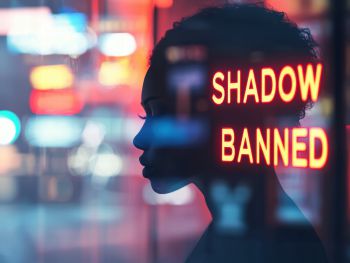Out of Sight, Out of Mind: How AI Shadow-Bans Contribute to the Algorithmic Erasure of Drag
Posted on behalf of: Morgan Ritchie, Sussex Law Clinic
Last updated: Monday, 23 June 2025

Shadow-banning, is the social media phenomenon where posts are strategically hidden from users without the posters knowledge. The justification is to ‘protect users from sexually suggestive, violent or harmful content’ but this is often misapplied and overly-targets the LGBTQIA+ community and other minorities. This begs the question: what is shadow-banning really protecting users from? It has been reported that Facebook, Instagram, TikTok and Twitter all participate in this practice. Shadow-bans have particularly negative implications on Drag performers that use these platforms as a source of income as it affects their posts reach, their engagement with other users and their ability to conduct business through these platforms. Shadow-banning is also particularly difficult to detect. This is because the banned-user is not notified and they post to a fake audience which effectively tricks them into not creating a new account.
The inherent issue with shadow-banning is that content deemed ‘sexually suggestive or sensitive’ is remotely undefined but is undoubtedly linked to gender politics and sexual orientation. This means that shadow-banning is strategically engineered to target queer expressions of gender, like a man in a dress, opposed to the straight white woman in a bikini. The issue of discriminatory shadow-banning is further exacerbated by the integration of AI into social media which has extended to content monitoring. This means that computerised systems are primarily responsible for flagging content and shadow-banning accounts. This demonstrates the dangers of automation bias, as humans rely on delegating tasks to AI under the belief that it will produce more fair and consistent results, despite evidence of the contrary. AI is human-made and carries our implemented biases and pre-conceptions, making it an imperfect tool in situations of discretion or subjectivity. This ‘perceived governance’ ultimately operates as a form of punishment and censorship for those pushing social boundaries of self-expression outside of gendered norms.
Despite a large cultural appreciation for the art of Drag, there is plenty of damaging rhetoric about “what is appropriate for kids” based on Bible morality standards. Current conservative attitudes about Drag already threaten the community and shadow-banning further contributes to a culture of ignorance and intolerance towards people that are different yet are a driving force in the arts & creative sector. These conclusions about AI bias perpetuates the argument that drag is inappropriate and dangerous. This negative discourse is intentional because social media is extremely political and there is obvious intention to control what content society consumes.
The reality is that drag is art, art is culture and culture drives movement. Social media platforms understand the power of Drag and ultimately use shadow-banning as a tool for fear-mongering and censorship of the voices they are afraid of. There is public outcry for reform and transparency about the shadow-banning practice, such as the #WeWantToSee Movement. Despite the attempts to silence the voices of these artists, Drag is not going to: “sashay away” and this hatred will only fuel the fight for equal representation.

